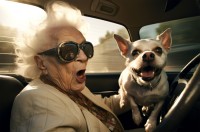Generation Experience: Why Marketing Is Missing a Huge Opportunity
200 Zeichen Lorem ipsum dolor sit amet, consectetuer adipiscing elit. Aenean commodo ligula eget dolor. Aenean massa. Cum sociis natoque penatibus et magnis dis parturient montes, nascetur ridiculus mus. Donec quu.
Kim Notz
22. August 2023
What do Cindy Crawford, Linda Evangelista, Christy Turlington, and Naomi Campbell have in common? They’re all well over 50—and yet they just appeared together on the cover of Vogue UK. The German edition of the Condé Nast title recently went even further, putting model icon and actress Lauren Hutton, at 79, on its cover and in a major fashion spread.
RTL, meanwhile, launched a podcast with Thomas Gottschalk and Mike Krüger, and Bild am Sonntag just ran a feature on “the happiness of life’s second half.” A study by the Institute for Integrative Healthcare and Health Promotion at the University of Witten/Herdecke had found that, contrary to popular belief, happiness does not peak at 40 and then decline.
The “generation of experience,” as I like to call the older population, has become a target group that media no longer shy away from—but actually celebrate. Marketing, however, still seems more eager to chase the supposedly hip Generation Z, missing out on a huge opportunity.
A Growing Audience with a Strong Appetite for Consumption
According to the World Health Organization (WHO), by 2050 around two billion people worldwide will be over 60 years old—twice as many as today. That makes the older generation one of the fastest-growing target groups globally. In Germany, by 2050 one in three people will be over 60 (source: Federal Statistical Office). This generation is not only significant in size, but its influence on product success is already enormous. A study by the market research firm GfK found that the 60+ generation currently accounts for around 44% of consumer spending—and the trend is rising.
All the more baffling, then, that while agencies and consultancies focused on Gen Z are springing up everywhere, only a handful are taking a serious look at the target group that, in fact, has everything marketers could wish for in a dream audience.
Lorem ipsum dolor sit amet, adipiscing elit.
High purchasing power is one thing—but just as important is the joy of consumption. While younger generations want to work less, have less money than their predecessors, and often take a more critical view of consumerism, older generations genuinely enjoy spending. They are also highly brand-loyal. A study by Splendid Research found that 44% of people over 60 stick with the brands they know.
Beyond that, the “generation of experience” values sustainability and quality. Products that embody these attributes—and communicate them clearly—stand a strong chance of being embraced by older consumers.
More Diverse Than Advertising Wants Us to Believe
The digital know-how of older generations is also widely underestimated. In Germany, 62% of people over 60 are online (source: Bundesverband Digitale Wirtschaft). Many use their smartphones not just for research but also for online shopping or booking theater tickets. The key is to connect the online and offline worlds seamlessly while ensuring accessibility in marketing. That includes very practical aspects such as store design, convenience, user-friendly products, and technology that is easy to understand.
Last but not least: stereotypes still dominate German advertising. Yet the “generation of experience” is just as diverse as any other demographic group. Campaigns like the one in the UK for the lubricant Replens—which portrayed older people in the context of sex and even showed aging, naked skin—are nowhere to be found in Germany. The only real exception at the moment is Kytta, a brand that dares to engage with this audience differently. Its current spot features only older nudists, showing a wide range of body shapes. At the same time, the protagonists appear life-affirming and unconventional.
By contrast, most advertising aimed at older consumers still depicts humorless, helpless people in beige tones. And yet this kind of communication completely misses a target group that, thanks to its purchasing power and brand loyalty, drives highly relevant revenues for companies.
Marketing departments should therefore align themselves with today’s lived realities. That also means building more diverse teams in both agencies and marketing departments. Only then can truly age-appropriate communication succeed. Whether it’s Gen Z or the “generation of experience,” the latter deserves just as much to be taken seriously and addressed appropriately as younger target groups.
Find more here:
Kontakt





